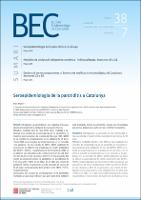Seroepidemiologia de la parotiditis a Catalunya
Author
Date
2017-07Permanent link
https://hdl.handle.net/11351/3497ISSN
2385-720X
DL
B. 11287-2015
Abstract
Introduction. Mumps is a virial disease that affects mainly individuals aged less than 30 years.
Methods and results. Since 1996 three seroprevalence studies in representative samples of the population have been carried out. Seroprevalence in population aged ≥5 years was studied in 1996 and 2003; and seroprevalence in neonates and pregnant women was studied in 2013. Studies carried out in 1996 and 2002 (population aged ≥5 years) found a prevalence of protective levels of 89.9% and 90,6%, respectively. The study carried out in 2013 found a prevalence of protective levels (>460 UI/ml) of 84,1% in neonates and 81,0% in pregnant women. Protective anti-mumps levels in population aged 5-44 years were <90% in 2002. In 2013 protective anti-mumps levels in neonates of mothers aged 15-29 years and in pregnant women aged 15-29 years were <80% and <75%, respectively. Conclusions. The studies of seroprevalence carried out in Catalonia suggest that a large part of the population is protected against mumps, although the current prevention strategy is not sufficient to control the disease.
Keywords
Bibliographic citation
Plans P. Seroepidemiologia de la parotiditis a Catalunya. Butll Epidemiol Catalunya. 2017 Jul;38(07):148-154.
Audience
Professionals
This item appears in following collections
- DS - Articles científics [409]
The following license files are associated with this item:

 Private area
Private area Contact Us
Contact Us








